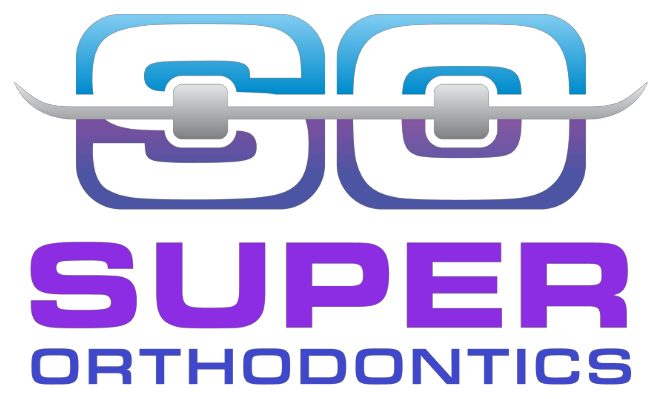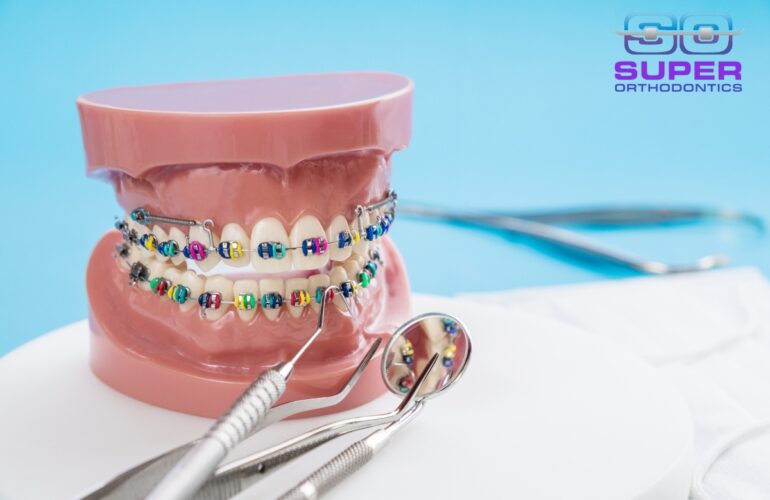Ensuring your child’s dental health begins with recognizing early signs your child may need braces or early orthodontic care. This article outlines key indicators that suggest your child might benefit from early orthodontic treatment, also known as Phase 1 Treatment.
Crowded or Crooked Teeth
One of the most noticeable signs is crowded or crooked teeth. When there isn’t enough space in the mouth for teeth to align properly, they may overlap or twist. This misalignment can hinder effective cleaning, leading to a higher risk of cavities and gum disease. Our expert orthodontic specialist at Super Orthodontics can assess your child’s dental alignment and recommend appropriate treatment as Phase 1 treatment to ensure optimal oral health for your child.
Overbite or Underbite Early Orthodontic Care
An overbite occurs when the upper front teeth excessively overlap the lower front teeth, while an underbite is characterized by the lower front teeth extending beyond the upper front teeth. These bite issues can impact chewing, speaking, and overall facial harmony. Specialists offer personalized solutions to correct these issues and provide the necessary intervention and early orthodontic care, enhancing your child’s smile and bite functionality.
Early or Late Loss of Baby Teeth
The timing of baby tooth loss can indicate developmental issues that may require orthodontic attention. If your child loses baby teeth significantly earlier or later than expected, it could affect the eruption pattern of permanent teeth. Orthodontists provide comprehensive evaluations to monitor dental development and recommend timely intervention if necessary.
Difficulty Chewing or Biting
Problems with chewing or biting can signal alignment issues that affect how teeth come together. If your child experiences discomfort while eating certain foods or has difficulty biting into foods like apples, it may be due to misaligned teeth and a sign that your child may need early orthodontic care. Orthodontic experts can diagnose the underlying causes and create a treatment plan tailored to your child’s needs.
Mouth Breathing & Early Orthodontic Care
Chronic mouth breathing can influence dental and facial development, potentially indicating orthodontic issues. Evaluations assess mouth breathing patterns to determine if they are related to dental alignment concerns. Early intervention can help correct these issues and promote proper breathing habits for better overall health.
Speech Difficulties
Speech impediments such as lisping or difficulty pronouncing certain sounds may stem from dental misalignment. Specialists are trained to assess the impact of orthodontic issues on speech and recommend appropriate orthodontic treatment options for your child. Correcting dental alignment can improve speech clarity and boost your child’s confidence in social interactions.
Jaw Pain or Popping
Pain or clicking sounds in the jaw joint when opening or closing the mouth can indicate a misaligned bite or TMJ disorder. Comprehensive evaluations identify these issues and provide targeted treatments to alleviate discomfort and restore jaw function for your child.

Misaligned Jaw
A visibly misaligned jaw can affect facial aesthetics and dental function. Specialists diagnose malocclusion and develop customized treatment plans using advanced orthodontic techniques. The goal is to achieve optimal alignment of the jaw and teeth for improved oral health and a confident smile.
Teeth Grinding
Teeth grinding, or bruxism, can lead to worn-down teeth and jaw pain. Specialists determine if misaligned teeth contribute to this condition and recommend braces to correct alignment issues. Early Orthodontic care addressing bruxism can prevent dental damage and promote long-term oral health.
Uneven Wear on Teeth
Uneven wear patterns on your child’s teeth may indicate bite problems that require orthodontic treatment. Focusing on restoring balance to your child’s bite can prevent tooth sensitivity, cavities, and other dental issues associated with uneven wear.

Additional Considerations for Early Orthodontic Care
In addition to the signs listed above, there are other considerations that may indicate your child could benefit from braces:
Genetic Factors
Genetics play a significant role in dental development and orthodontics, as they largely determine the size and shape of the jaw, the alignment of teeth, and overall facial structure. Inherited traits such as tooth crowding, spacing, and bite alignment can influence the need for orthodontic treatment. Understanding a patient’s genetic background helps orthodontists anticipate potential issues and tailor treatment plans that align with the individual’s unique genetic predispositions, leading to more effective and personalized care. If you or your partner required orthodontic treatment as a child, there’s a higher likelihood that your child may also need braces. Monitoring dental growth and development from an early age can help identify potential issues early on.
Thumb Sucking or Pacifier Use
Extended thumb sucking or pacifier use beyond toddler years can affect dental alignment. These habits can push teeth out of position, leading to an overbite, open bite, or other alignment issues. Encouraging your child to stop these habits early can mitigate potential orthodontic problems.
Facial Structure and Bite Evaluation
An orthodontist evaluates not only the alignment of teeth but also the overall facial structure and bite relationship. Issues such as a recessed chin, protruding teeth, or asymmetrical facial features can indicate a need for orthodontic treatment to improve both aesthetics and function.
Early Orthodontic Intervention Benefits
Early intervention with braces can offer numerous benefits for your child’s oral health and overall well-being:
- Preventive Measures: Addressing orthodontic issues early can prevent more severe problems in the future, such as impacted teeth or difficulty chewing and speaking.
- Facilitate Proper Growth: Braces guide the growth of jaw bones and permanent teeth, ensuring they come in correctly aligned.
- Boost Confidence: A straight, healthy smile can improve self-esteem and social confidence in children and adolescents.
Choosing the Right Time for Orthodontic Treatment
Orthodontic treatment timing depends on the individual child’s needs and development. While braces are often associated with adolescence, some children may benefit from early treatment, known as Phase I treatment, to address specific issues before all permanent teeth erupt.
Conclusion
Early detection and intervention of orthodontic issues are crucial for your child’s dental health and overall well-being. If you notice early signs your child needs braces, schedule a consultation with an orthodontist. At Super Orthodontics, we are dedicated to providing compassionate care and innovative solutions to help your child achieve a healthy, functional, and beautiful smile for life. Contact us today to learn more about how we can assist you on this journey to optimal oral health.





